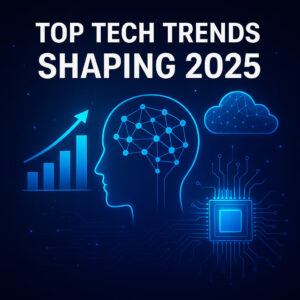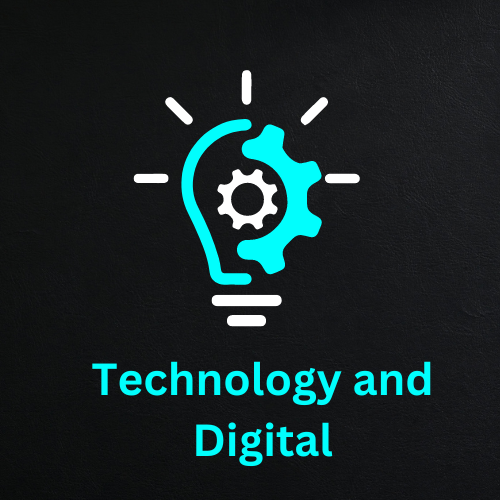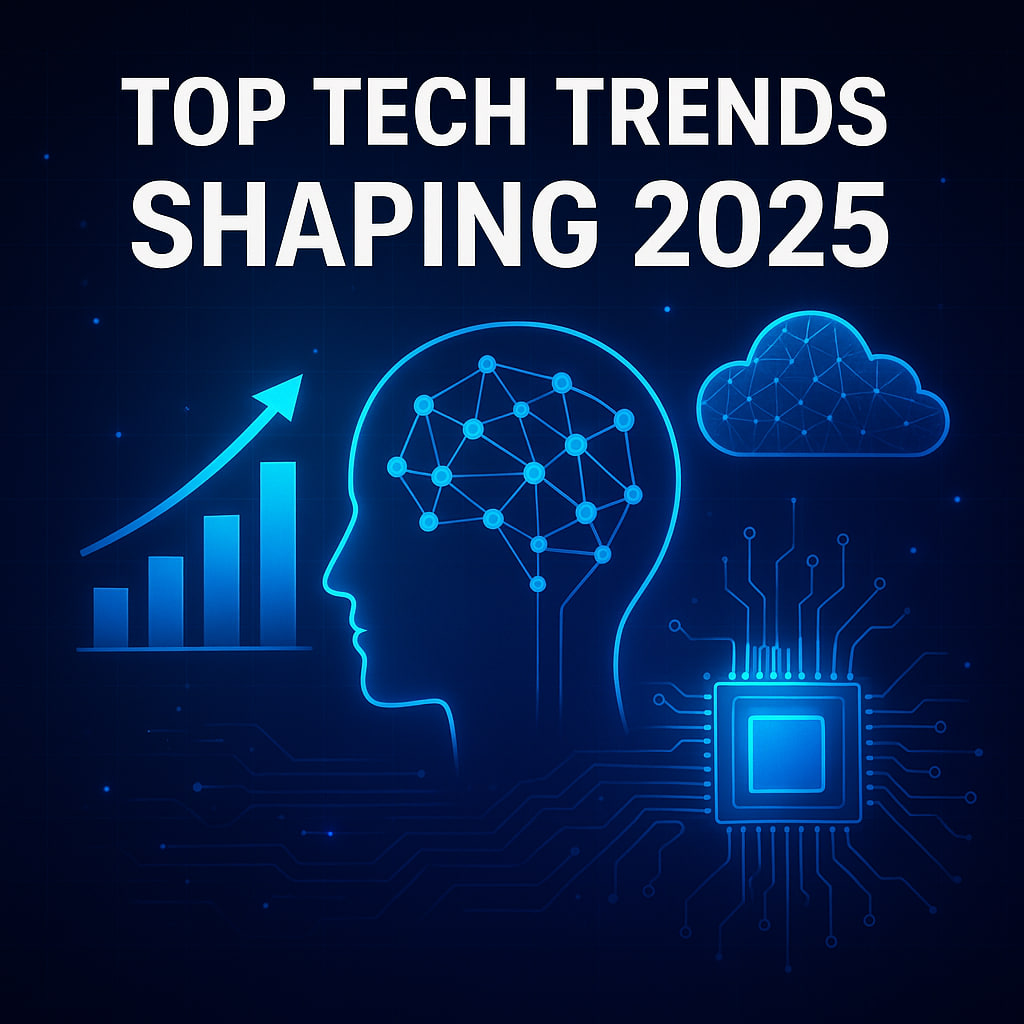Top Tech Trends Shaping 2025

Technology in 2025 grows faster than ever. Innovations once seen as futuristic are becoming everyday tools. This article explores the major tech trends emerging now—what they are, why they matter, and how they might change how people live and work.
Introduction: A Moment of Convergence
In the past few years, many separate advances—AI, connectivity, edge computing—have matured enough to converge. Today, they feed into each other and unlock capabilities that none could deliver alone. The trends highlighted below reflect that synergy. For readers from beginners to enthusiasts, these signal areas to explore, adopt, or at least watch closely.
1. Agentic AI: Autonomous Intelligence Takes Off
What It Means
Agentic AI refers to systems that not only respond to prompts, but **act** autonomously across multiple steps. Instead of only generating text or suggestions, they can plan, decide, and execute tasks without direct human input.
Why It’s Emerging Now
Foundation models are becoming more capable, and orchestration layers are evolving. Businesses push for automation beyond simple scripts. Analysts rank agentic AI among the top tech trends for 2025. :contentReference[oaicite:0]{index=0}
Practical Tip
Start pilot projects where a multi-step task is defined (e.g. handling customer onboarding). Use agentic modules to automate parts and monitor behavior. This reveals challenges before full rollout.
2. Micro LLMs and On‑Device AI
Trend Overview
Large Language Models (LLMs) are being compressed into smaller, efficient versions that can run locally on devices. These “micro LLMs” reduce dependence on cloud inference and lower latency.
Why It Matters
Mobile hardware is improving. Privacy concerns discourage sending all data to the cloud. Running AI locally saves bandwidth and gives real-time responsiveness.
Tip for Developers
Experiment with quantized or distilled models for features like offline text completion or suggestions. Evaluate trade-offs in size vs. accuracy against latency.
3. Spatial Computing and XR Everywhere
Defining the Trend
Spatial computing blurs boundaries between physical and virtual worlds using AR, VR, and Mixed Reality (XR). Objects, interfaces, and environments become interactive overlays. :contentReference[oaicite:1]{index=1}
Where It’s Already Visible
- Architects reviewing 3D models overlaid on real spaces
- Remote collaboration via virtual rooms
- Training in AR simulations for medical, industrial, or safety workflows
How to Try It
Start with lightweight AR apps or prototypes. Use off-the-shelf toolkits like ARCore/ARKit. Focus on user experience and ergonomics—don’t force spatial just for novelty.
4. 5G‑Advanced & Early 6G Foundations
Progress in Connectivity
5G is evolving into **5G‑Advanced** (sometimes 5.5G), offering higher throughput, better efficiency, more intelligent resource allocation. :contentReference[oaicite:2]{index=2} Meanwhile, 6G research has started, with goals for teraHertz bands, massive sensing, and ultra‑low latency systems. :contentReference[oaicite:3]{index=3}
Impact on Tech Systems
Edge AI, autonomous vehicles, remote controls, robotics—all depend on better connectivity. The shift is toward distributed compute powered by faster, smarter wireless networks.
Advice for Planners
Design systems to adapt: support fallback paths (WiFi, 4G) where 5G‑Advanced is not available. Use network slicing where possible. Monitor actual latency and bandwidth rather than assumptions.
5. Edge AI & Distributed Intelligence
What It Brings
Processing moves closer to sensors and devices. Rather than always sending raw data to central servers, analysis, decisioning, and filtering occur at the “edge.”
Advantages
- Lower latency for time-sensitive tasks (e.g. robotics, industrial monitoring)
- Reduced bandwidth and cloud cost
- Better privacy—sensitive data can stay local
- Continuity even when network connection is poor
Practical Tip
Partition your workloads: decide what must be computed locally and what can be deferred to central servers. Use container-based deployment to push updates smoothly.
6. Quantum & Post‑Quantum Technologies
Quantum Progress
Quantum computing is gradually moving into early commercial use—especially in optimization, materials, and cryptography. :contentReference[oaicite:4]{index=4}
Post‑Quantum Cryptography
As quantum threats loom, cryptographic standards shift. Algorithms resistant to quantum attacks are already under standardization. :contentReference[oaicite:5]{index=5}
Where to Focus
Review cryptographic components, assess exposure, and begin planning for post‑quantum transitions. Monitor quantum computing advances relevant to your domain (e.g. supply chains, simulation workloads).
7. AI‑Driven Cybersecurity & Trust
Evolving Threat Landscape
Adversaries use AI too—adversarial attacks, automated exploits, social engineering at scale. Defenses must match pace.
How AI Helps Defense
- Real-time anomaly detection based on behavior
- Automated threat response and isolation
- Adaptive authentication based on context
- Data integrity verification via AI models
Implementation Tip
Start by protecting critical assets (e.g. identity systems, finance). Build detection pipelines that learn from data. Avoid simply adding more rules; aim for systems that evolve.
8. IoT, Wearables & Earable Evolution
IoT Maturity
Connected devices keep growing—homes, industries, cities. In 2025, IoT becomes more autonomous and interoperable. :contentReference[oaicite:6]{index=6}
Wearables and Earables
Wearables now go beyond steps and heart rate. Earables—devices in or around the ear—combine sensors, audio, health monitoring, and interaction. :contentReference[oaicite:7]{index=7}
Advice for Designers
Focus on battery, ergonomic design, sensor fusion, and data compression. Prioritize seamless connectivity and integration.
9. Modularity, Microservices & Low‑Code Architectures
Why the Shift
Large monolithic systems stifle agility. Modular microservices, combined with low-code or no-code tools, enable faster changes by smaller teams. :contentReference[oaicite:8]{index=8}
How to Apply
Break functionality into clear services. Use APIs and versioning. Provide business teams access with low-code front ends tied to modular back ends.
10. What to Watch Out For & Adoption Strategies
Ethics, Bias & Oversight
Autonomous systems must be held accountable. Bias in data or design can magnify harms. Building transparency and audit capabilities is essential.
Operational Complexity
Many moving parts, distributed systems, and cross-layer dependencies increase complexity. Monitoring, testing, and observability must be baked in early.
Cost Control
Scalable systems can overshoot budgets. Use quotas, guardrails, and usage monitoring to avoid runaway costs.
Adoption Strategy
- Start small with pilots in noncritical domains
- Measure metrics: latency, cost, error rates, adoption
- Iterate design before scaling broadly
- Invest in observability, security, show value early
Conclusion: Moving Into a New Era
The tech frontier in 2025 is not about single breakthroughs—it’s about **integration**. Agentic AI, edge intelligence, spatial computing, and secure networks all combine to deliver experiences that were unimaginable a decade ago. Adopting these trends is a journey: begin small, validate impact, and build resilient foundations.
Which trend resonates most for your domain? Prototype boldly, learn quickly, and evolve systems over time. The next wave of innovation is already here.
What’s your experience with any of these trends? Share ideas, questions, or use cases—this community thrives on real insights.




